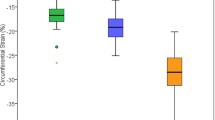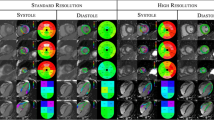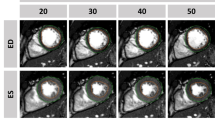Abstract
Sparsely sampled cardiac cine accelerated acquisitions show promise for faster evaluation of left-ventricular function. Myocardial strain estimation using image feature tracking methods is also becoming widespread. However, it is not known whether highly accelerated acquisitions also provide reliable feature tracking strain estimates. Twenty patients and twenty healthy volunteers were imaged with conventional 14-beat/slice cine acquisition (STD), 4× accelerated 4-beat/slice acquisition with iterative reconstruction (R4), and a 9.2× accelerated 2-beat/slice real-time acquisition with sparse sampling and iterative reconstruction (R9.2). Radial and circumferential strains were calculated using non-rigid registration in the mid-ventricle short-axis slice and inter-observer errors were evaluated. Consistency was assessed using intra-class correlation coefficients (ICC) and bias with Bland–Altman analysis. Peak circumferential strain magnitude was highly consistent between STD and R4 and R9.2 (ICC = 0.876 and 0.884, respectively). Average bias was −1.7 ± 2.0 %, p < 0.001, for R4 and −2.7 ± 1.9 %, p < 0.001 for R9.2. Peak radial strain was also highly consistent (ICC = 0.829 and 0.785, respectively), with average bias −11.2 ± 18.4 %, p < 0.001, for R4 and −15.0 ± 21.2 %, p < 0.001 for R9.2. STD circumferential strain could be predicted by linear regression from R9.2 with an R2 of 0.82 and a root mean squared error of 1.8 %. Similarly, radial strain could be predicted with an R2 of 0.67 and a root mean squared error of 21.3 %. Inter-observer errors were not significantly different between methods, except for peak circumferential strain R9.2 (1.1 ± 1.9 %) versus STD (0.3 ± 1.0 %), p = 0.011. Although small systematic differences were observed in strain, these were highly consistent with standard acquisitions, suggesting that accelerated myocardial strain is feasible and reliable in patients who require short acquisition durations.




Similar content being viewed by others
References
Hor KN, Gottliebson WM, Carson C, Wash E, Cnota J, Fleck R, Wansapura J, Klimeczek P, Al-Khalidi HR, Chung ES, Benson DW, Mazur W (2010) Comparison of magnetic resonance feature tracking for strain calculation with harmonic phase imaging analysis. JACC Cardiovasc Imaging 3(2):144–151
Augustine D, Lewandowski AJ, Lazdam M, Rai A, Francis J, Myerson S, Noble A, Becher H, Neubauer S, Petersen SE, Leeson P (2013) Global and regional left ventricular myocardial deformation measures by magnetic resonance feature tracking in healthy volunteers: comparison with tagging and relevance of gender. J Cardiovasc Magn Reson 15(1):8
Cowan BR, Peereboom SM, Greiser A, Guehring J, Young AA (2015) Image feature determinants of global and segmental circumferential ventricular strain from cine CMR. JACC Cardiovasc Imaging 8 (12):1465–1466. doi:10.1016/j.jcmg.2014.10.005
Pedrizzetti G, Claus P, Kilner PJ, Nagel E (2016) Principles of cardiovascular magnetic resonance feature tracking and echocardiographic speckle tracking for informed clinical use. J Cardiovasc Magn Reson 18 (1):51. doi:10.1186/s12968-016-0269-7
Helle-Valle T, Crosby J, Edvardsen T, Lyseggen E, Amundsen BH, Smith HJ, Rosen BD, Lima JA, Torp H, Ihlen H, Smiseth OA (2005) New noninvasive method for assessment of left ventricular rotation: speckle tracking echocardiography. Circulation 112 (20):3149–3156. doi:10.1161/CIRCULATIONAHA.104.531558
Lustig M, Donoho D, Pauly JM (2007) Sparse MRI: the application of compressed sensing for rapid MR imaging. Magn Reson Med 58 (6):1182–1195. doi:10.1002/mrm.21391
Velikina JV, Samsonov AA (2015) Reconstruction of dynamic image series from undersampled MRI data using data-driven model consistency condition (MOCCO). Magn Reson Med 74 (5):1279–1290. doi:10.1002/mrm.25513
Liu J, Rapin J, Chang T-C, Lefebvre A, Zenge M, Mueller E, Nadar MS (2012) Dynamic cardiac MRI reconstruction with weighted redundant Haar wavelets. Paper presented at the ISMRM, 2012
Vincenti G, Monney P, Chaptinel J, Rutz T, Coppo S, Zenge MO, Schmidt M, Nadar MS, Piccini D, Chevre P, Stuber M, Schwitter J (2014) Compressed sensing single-breath-hold CMR for fast quantification of LV function, volumes, and mass. JACC Cardiovasc Imaging 7 (9):882–892. doi:10.1016/j.jcmg.2014.04.016
Vardoulis O, Monney P, Bermano A, Vaxman A, Gotsman C, Schwitter J, Stuber M, Stergiopulos N, Schwitter J (2015) Single breath-hold 3D measurement of left atrial volume using compressed sensing cardiovascular magnetic resonance and a non-model-based reconstruction approach. J Cardiovasc Magn Reson 17:47. doi:10.1186/s12968-015-0147-8
Beck A, Teboulle M (2009) A fast iterative shrinkage-thresholding algorithm for linear inverse problems. Siam J Imaging Sci 2(1):183–202. doi:10.1137/080716542
Young AA, Cowan BR, Thrupp SF, Hedley WJ, Dell’Italia LJ (2000) Left ventricular mass and volume: fast calculation with guide-point modeling on MR images. Radiology 216(2):597–602
Li B, Liu Y, Occleshaw CJ, Cowan BR, Young AA (2010) In-line automated tracking for ventricular function with magnetic resonance imaging. JACC Cardiovasc Imaging 3(8):860–866
Cowan BR, Young AA, Anderson C, Doughty RN, Krittayaphong R, Lonn E, Marwick TH, Reid CM, Sanderson JE, Schmieder RE, Teo K, Wadham AK, Worthley SG, Yu CM, Yusuf S, Jennings GL (2009) Left ventricular mass and volume with telmisartan, ramipril, or combination in patients with previous atherosclerotic events or with diabetes mellitus (from the ONgoing Telmisartan Alone and in Combination With Ramipril Global Endpoint Trial [ONTARGET]). Am J Cardiol 104(11):1484–1489
Young AA, Li B, Kirton RS, Cowan BR (2012) Generalized spatiotemporal myocardial strain analysis for DENSE and SPAMM imaging. Magn Reson Med 67 (6):1590–1599. doi:10.1002/mrm.23142
Kim HY (2013) Statistical notes for clinical researchers: Evaluation of measurement error 1: using intraclass correlation coefficients. Restor Dent Endod 38 (2):98–102. doi:10.5395/rde.2013.38.2.98
R Core TEAM (2014) R: a language and environment for statistical computing. http://www.R-project.org/.
Kido T, Watanabe K, Urusibata Y, Knakamura M, Schmidt M, Zenge M, Mochizuki T (2015) Single breath-hold real-time MR cardiac cine for evaluation of left ventricular function. J Cardiovasc Magn Reson 17(Suppl 1):O63
Smith PM, Freed BH, Allen BD, Spottiswoode BS, Carr M, Wasielewski M, Campione K, Cordts M, Guetter C, Jolly MP, Schmidt M, Nadar MS (2014) Biventricular strain analysis at 1.5 T cardiac MR imaging: preliminary results in volunteers using an iterative SENSE reconstruction with L1 regularization. J Cardiovasc Magn Reson 16(Suppl 1):W4
Young AA, Cowan BR, Schoenberg SO, Wintersperger BJ (2008) Feasibility of single breath-hold left ventricular function with 3 T TSENSE acquisition and 3D modeling analysis. J Cardiovasc Magn Reson 10(1):24
Feng L, Srichai MB, Lim RP, Harrison A, King W, Adluru G, Dibella EV, Sodickson DK, Otazo R, Kim D (2013) Highly accelerated real-time cardiac cine MRI using k-t SPARSE-SENSE. Magn Reson Med 70 (1):64–74. doi:10.1002/mrm.24440
Taylor RJ, Moody WE, Umar F, Edwards NC, Taylor TJ, Stegemann B, Townend JN, Hor KN, Steeds RP, Mazur W, Leyva F (2015) Myocardial strain measurement with feature-tracking cardiovascular magnetic resonance: normal values. Eur Heart J Cardiovasc Imaging 16 (8):871–881. doi:10.1093/ehjci/jev006
Acknowledgments
This work was funded by Siemens Healthcare GmbH and the Health Research Council of New Zealand. We thank Michael Zenge PhD (Siemens Healthcare GmbH) for providing the pulse sequence.
Author information
Authors and Affiliations
Corresponding author
Ethics declarations
Conflict of interest
BRC and AAY report receiving consulting fees from Siemens Healthcare GmbH; AG and MS are employees of Siemens Healthcare GmbH.
Ethical standards
All human studies were approved by the appropriate ethics committees and have therefore been performed in accordance with the ethical standards laid down in the 1964 Declaration of Helsinki and its later amendments. All persons gave their informed consent prior to their inclusion in the study. Details that might disclose the identity of the subjects under study have been omitted.
Rights and permissions
About this article
Cite this article
Langton, J.E.N., Lam, HI., Cowan, B.R. et al. Estimation of myocardial strain from non-rigid registration and highly accelerated cine CMR. Int J Cardiovasc Imaging 33, 101–107 (2017). https://doi.org/10.1007/s10554-016-0978-x
Received:
Accepted:
Published:
Issue Date:
DOI: https://doi.org/10.1007/s10554-016-0978-x




